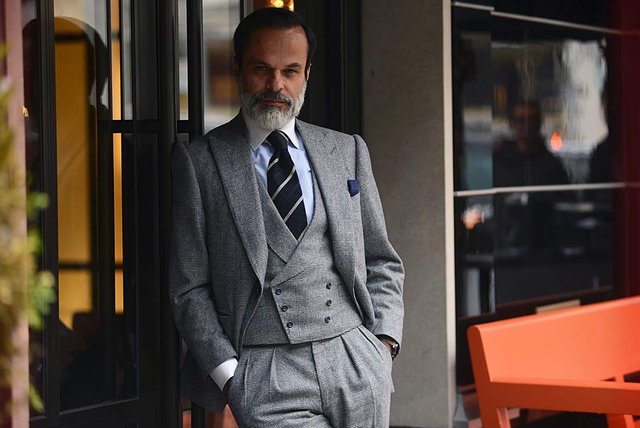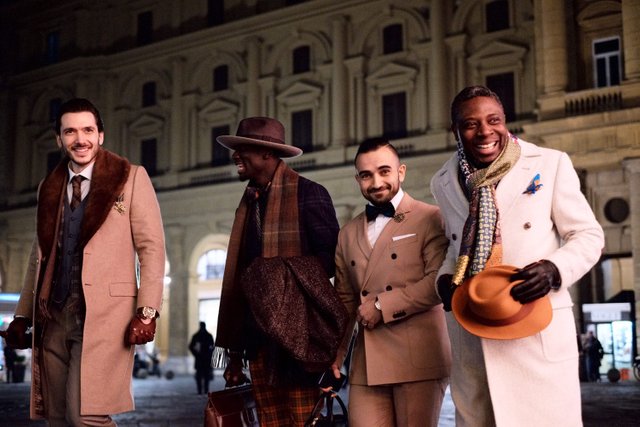A Classic Man
In the 19th ct, a dandy Beau Brummel invented a new way of men's representation - simplified cut and dim colours of close fitted tailored suit became widely accepted and the image acted as a prototype of classic men's cut for the centuries to come. Perhaps the saying that suit makes a man makes the suit seem omnipotent, but suit can certainly make or break an image - it is a communicative tool in the world of gentlemen’s culture, tradition, manners and heritage and if well done it can make one feel more viril and powerful.
So what does it means to be a gentleman? Hugo Jacomet, the creator of the Parisian Gentleman, a reputable menswear blog, says that "Being a gentleman is an attitude. A gentleman is someone who has the ability to put every person he interacts with at ease. There is a misinterpretation that people dress well to have the light on them, and that is completely reverse of how the gentleman should act.'' He says that the reason why men dress the same in the formal occasions, where the black tie is required, it’s because they have given up the attention for their better halves.
Although there are speculations of extinction of the old school manners of dress, it seems that in a world lacking deeper value due to mass and hyper-production, consumers tend to practice old-fashioned behaviour. Andrea Luparelli, the owner of Sartoria Ripense in Rome, thinks that the old things are more beautiful than the new ones and that classic tailoring is timeless.

Image source: parisiangentleman.co.uk
Heritage of Sartoria Italiana – Renato Ciardi, one of the best Neapolitan tailors in his workshop
The Suit
A modern western suit was born in London and English style and fabric were internationally considered the epitome of elegance. In the 19th century, the male silhouette came to the form we know today, and the criterion for a well-tailored jacket was a careful made to measure fit. The aim was is to emphasize the monumentality of the masculine body.
A jacket should stand firmly on the body and this solid shape came from a technique called canvassing. The result is clean cut, impeccable fit and shape. When making a suit, it is important to pick a quality material like luxury wools, merino wool, mohair, cashmere, or in south often linen and silk.
There are three types of suit:
The double-breasted suit is very elegant, very structured and always worn buttoned up.
The single-breasted suit makes the wearer visually taller and slimmer in the waistline.
Three-piece-suit was once only worn on a very formal occasions, and today is well accepted regardless of the occasion, and the waistcoat is worn only with a single-breasted suit.

Image source: guerreisms.com
Three-piece-suit by Cifonelli, Parisian prominent bespoke house

Image source: www.zegna.co.uk
Ermenegildo Zegna is known for high-quality and innovative fabrics like fully washable luxury wool named Techmerino wool.
The Cut
For a hundred years, the suit is made using the same methods. Most of the operations are manual work and it takes about 60 hours to complete one suit. The process is pretty much the same in any geographical area, but there are some differences in opinions on what a man should look like.
British tailoring is home to modern tailoring, it's more about conventions, class and etiquette, and for a long time, it was considered to be of the highest quality. Traditional English cut found its inspiration in military uniform, horse riding and hunting clothes. Savile Row street in London is famous for being a birthplace of British menswear. Dedicated to political leadership and military elite in the 1700s, it became a target for British merchants of luxury goods.
The British man is characterized by the more fitted waist and strong shoulders, while the south due to higher temperatures, approves softer, relaxed forms. However, this is a rough distinction, because both areas cultivate variety of silhouettes and styles, and in Italy almost every region has its own style.
In essence, the only major difference is that a British intention is to look like an intellectual from the upper class, and the Italian is very proud of his attractive and elaborate appearance.

The Italian style is expressive and free (Pitti Uomo, Florence)
Italian cut is derived from British and shaped by world-known fashion makers Ermenegildo Zegna, Nazareno Fonticoli (founder of Brioni) and Armani. Italian tailors focus on creating a cut that flatters the figure with a pronounced waist, a bit shorter jacket and narrow trousers, which gives the impression of a slim figure with long legs. In Italy the emphasis is on freedom of attitude expressed in bold colours and daring fabrics, and nearly every region has its own silhouette. Tailor in the North usually prefers a square cut, while the tailor from the south prefers a natural, soft garment. Both are dedicated to a lot of handwork.
The industry is led by mostly retired tailors who are passing their craft on to the next generations.
Congratulations @katarinabar! You have completed the following achievement on the Steem blockchain and have been rewarded with new badge(s) :
Click here to view your Board
If you no longer want to receive notifications, reply to this comment with the word
STOPDo not miss the last post from @steemitboard:
@katarinabar, thank you for supporting @steemitboard as a witness.
Click on the badge to view your Board of Honor.
Once again, thanks for your support!
Do not miss the last post from @steemitboard:
Thank you so much for sharing this amazing post with us!
Have you heard about Partiko? It’s a really convenient mobile app for Steem! With Partiko, you can easily see what’s going on in the Steem community, make posts and comments (no beneficiary cut forever!), and always stayed connected with your followers via push notification!
Partiko also rewards you with Partiko Points (3000 Partiko Point bonus when you first use it!), and Partiko Points can be converted into Steem tokens. You can earn Partiko Points easily by making posts and comments using Partiko.
We also noticed that your Steem Power is low. We will be very happy to delegate 15 Steem Power to you once you have made a post using Partiko! With more Steem Power, you can make more posts and comments, and earn more rewards!
If that all sounds interesting, you can:
Thank you so much for reading this message!